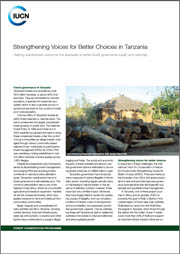Strengthening Voices for Better Choices in Tanzania
Helping stakeholders overcome the obstacles to better forest governance locally and nationally

Photo: IUCN
Forest governance in Tanzania
Tanzania’s forests and woodlands cover 33.5 million hectares, or about 40% of its land area. They are dominated by miombo woodland, a species-rich savannah ecosystem which is also a valuable source of goods and services for the country’s mostly poor rural population.
Only two-fifths of Tanzania’s forests lie within forest reserves or national parks. The rest is unreserved and largely unprotected forest growing on public land. The National Forest Policy of 1998 and Forest Act of 2002 explicitly recognised the need to bring these unreserved forests under the control of local communities as village forests, managed through various community-based regimes known collectively as participatory forest management (PFM). By 2006, PFM was operating or being established in over 3.6 million hectares of forest spread across 1,800 villages.
Despite its progressive policy framework aimed at decentralising forest management, encouraging PFM and ensuring forests contribute to national poverty alleviation goals, Tanzania’s overall performance in forest governance is still relatively poor. The country’s deforestation rate is one of the highest in East Africa, driven by uncontrolled agriculture and livestock expansion. Hardest hit are the unreserved forests, which face greater pressure for land and fuelwood from surrounding communities.



